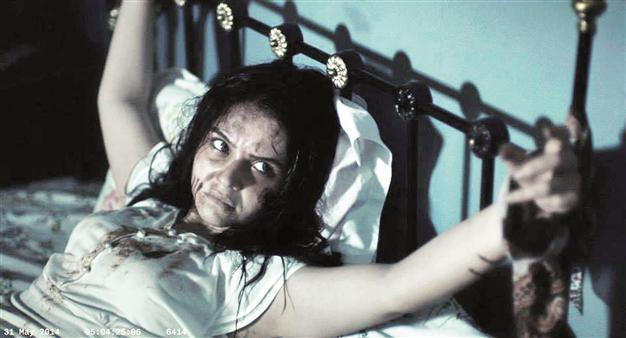Jinnis scare Turkish audiences most
ISTANBUL – Anadolu Agency
 Films such as “Dabbe: Zehr-i Cin,” “Siccin” and “Azazil: Düğüm” have emerged as 2014’s horror blockbusters in Turkish cinema. Turkish horror cinema, which has revived in recent years, draws more attention from viewers.
Films such as “Dabbe: Zehr-i Cin,” “Siccin” and “Azazil: Düğüm” have emerged as 2014’s horror blockbusters in Turkish cinema. Turkish horror cinema, which has revived in recent years, draws more attention from viewers.According to data provided by Box Office Turkey, Hasan Karacadağ’s “Dabbe” series’ latest film “Dabbe: Zehr-i Cin” was released on Sept. 12 and received a record number of viewers with 836,232 in 12 weeks. The film’s total revenue was 8,335,630 Turkish Liras.
Karacadağ is one of the Turkish horror film directors who mostly depicts jinnis in his films. His film was a blockbuster among Turkish and foreign horror films this year.
His five films “Dabbe,” “Dabbe 2,” “Dabbe: Bir Cin Vakası,” “Dabbe: Cin Çarpması” and “Dabbe: Zehr-i Cin” drew 2,432,840 people to movie theaters.
Karacadağ states that he has claimed since his first film that local, cultural and historic factors would scare Turkish viewers. “People did not believe it at first. Actually, our people have been influenced by horror factors fed by the concept of jinni or cultural codes. But it was unbelievable that it could not be adapted to cinema,” he said.
“The jinni’s world is a nonvisible and unknown world. It was questioned how it could be adapted to cinema.”
Karacadağ said he was making his ninth film, adding, “We have learned through time how to convey it to viewers. Nearly 850,000 people in Turkey and 150,000 people abroad have seen my latest film. It is very important to show viewers a story of their own culture and history, and to make it in the quality of international horror films. We did not reach that audience if we have not yet reached this quality. In this case, we are on the right track,” he said.
Based on true events
“Siccin,” the new film by the director of the series “Musallat” (Haunted), Alper Mestçi, was viewed by 334,914,000 people in 10 weeks.
Starring Pınar Çağlar Gençtürk, Koray Şahinbaş, Ebru Kaymakçı and Merve Ateş, the film earned a revenue of 3,460,257 liras.
The film, based on true events, tells the painful love story of a woman named Öznur.
“Azazil: Düğüm” (Azazil: Knot), a film based on the extraordinary experiences of metaphysics and bioenergy expert Salih Memişoğlu, was seen by 178,584 people in 14 weeks.
Starring Cansu Diktaş, Tolga Akman, Nurten İnan, Zafer Altun and Murat Ercanlı, the film was written by Özgür Bakar and Alper Kıvılcım and brought 1,665,309 liras of revenue.
Memişoğlu, who is interested in issues like metaphysics and parapsychology, says the film, which depicts the dilemma of doctor and religious scholar about the incidents involving jinnis and demons through the viewpoints of scientists, drew interest because it is based on events believed to be true.
He says the film is based on a section of al-Falaq, the 113th surah of the Quran, and he depicts the experiences of people in the film. He says the second part of the film will be made in the coming days, adding that they are focusing on the details.
Concepts have associations in Turkish films
Psychologist Fatih Reşit Civelekoğlu says for a person to fear something, this fear should be associated with something on this person’s brain; it should have a definition.
He says that foreign horror elements such as “vampires,” “werewolves” and “Dracula,” do not receive much interest because they do not have a definition in the Turkish society’s subconscious.
“The concepts in Turkish horror films have a definition in the brain. Every person, especially from childhood, learns these concepts and, moreover, has some experiences related to them. Accordingly, when these concepts in the subconscious are seen in films, the images and events in the film trigger repressed fears caused by experiences,” says Civelekoğlu.
He says the makers of Turkish horror films know Turkish people very well, adding, “They use religious and cultural arguments in their films. Each of these has a definition in the subconscious of Turkish people. These arguments boost the film’s credibility and it becomes more effective on people.”
















